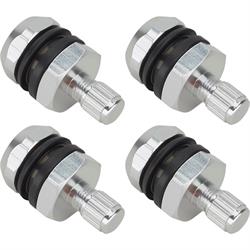Racing Wheel Technology Guide - Components and Design
Beadlock Rings
Beadlock rings are simply designed to secure the bead of the tire to the wheel. In dirt track racing, the tires are inflated with lower pressures in order to gain more surface area contact, and typically the tires have a coarse tread design. Clamping the bead of the tire to the rim then prevents the tire from slipping or rolling off the rim. Speedway offers a universal weld-on style beadlock kit and several options that are manufacturer specific, including Aero, Bassett, Sander Engineering, and Weld Racing. Beadlock rings are manufacturer-specific and typically will not interchange between each brand of wheel.
Lug Nuts
It’s a simple concept - keep the wheels on the car. This is important for obvious reasons, but making sure your lug nuts match-up to your wheel and stud combination is often overlooked. One of the most common mistakes is to install lug nuts with an incorrect taper to match the wheel. To break it down, there are three basic types of lug nuts: acorn-style, opened-ended, and shank or mag-style. Other than mag-style, most lug nuts will have either a 90-degree seat taper or a 60-degree taper. A 90-degree taper is commonly used on racing wheels, while most aftermarket street wheels require a 60-degree taper. When it comes time to select a set of lug nuts, be sure to know the stud thread size and length in order to match the correct lug nuts. If you’re unsure what the wheel requires, you can always consult the individual wheel manufactures for specifications.
Mud Covers
Unnecessary weight is a huge concern in racing, and mud covers do an excellent job preventing dirt or debris from collecting inside the wheel. Speedway offers a variety of mud plugs and mud covers that fit several different wheel designs. For non-beadlock wheels, Bassett and Aero offer mud guards that attach to a ring that is installed to the inside of the wheel. Manufactures like Speedway, Sander, and Weld Racing, have designed covers that attach directly to a beadlock ring using quarter turn fasteners or hardware.
Wheel Adapters and Spacers
Wheel adapters are used to change a specific hub bolt pattern to a different wheel bolt pattern. One common example would be: if you have a 9-inch Ford rearend (5-on-4 ½ hub pattern) and need to use wheels with 5-on-4 ¾ (Chevy) bolt pattern. Speedway offers several wheel adapters from Trans-Dapt that are supplied in a variety of bolt circle combinations. Wheel spacers sometimes catch a bad rap, but the truth is if the spacers are used properly they can be a very useful tool. Wheel spacers can improve the look, suspension clearance, and handling by moving the wheels further out, and widening the track width. The number one rule when you’re installing any spacer is: make sure that you have the proper thread engagement after the spacer and wheel are installed. If there is only 1/4-inch of threads showing, you may want to consider longer wheel studs or another solution.
Valve Stems
There are three common styles of valve stems: rubber snap-in, steel bolt-in, and aluminum bolt-in. The driving conditions and wheel design are usually what determines which valve stem is most suitable for your wheel. It’s recommended to use a metal bolt-in style valve stem on off-road or track conditions. Or if you’re simply trying to accent an aluminum or chrome wheel, steel and aluminum valve stems may work the best. The valve stems we offer are available in two main sizes: .453-inch hole size, which are common on street wheels, and .625-inch, which are common on racing wheels. Standard valve stems, rubber or bolt-in, have a maximum inflation pressure of 65psi.



